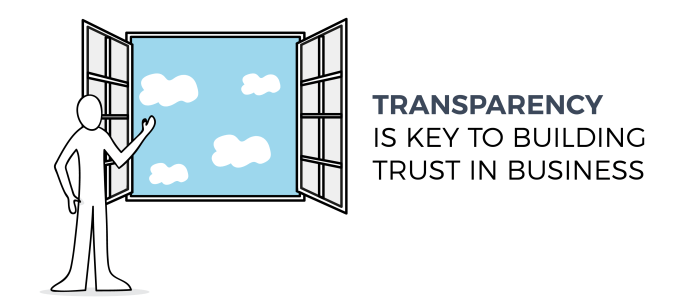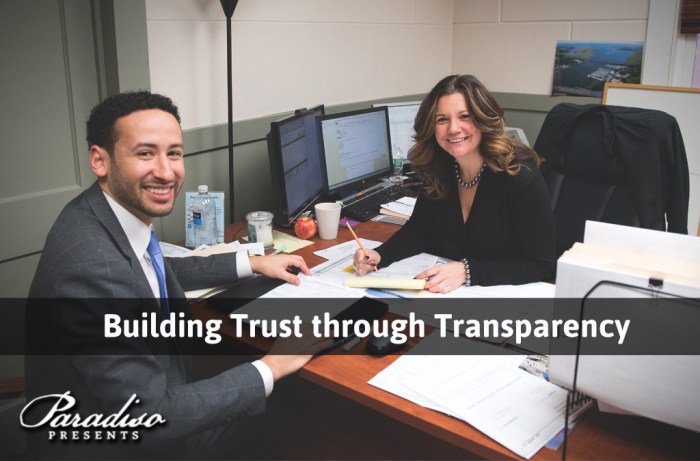Building Trust Through Transparency sets the stage for enhancing relationships by delving into the importance of openness and honesty in various industries, ultimately leading to increased credibility and trust. Get ready to explore how transparent practices can revolutionize communication strategies and decision-making processes.
Importance of Transparency
Transparency plays a crucial role in building trust between individuals, organizations, and communities. When information is openly shared and communication is honest, it creates a foundation of trust that fosters stronger relationships and collaborations.
Enhances Accountability
Transparency holds individuals and organizations accountable for their actions and decisions. By being transparent about processes, outcomes, and challenges, it allows others to assess and evaluate the credibility and integrity of those involved.
Promotes Open Communication
Transparency encourages open communication and information sharing. When there is transparency, people feel more comfortable expressing their thoughts, concerns, and feedback, leading to a more collaborative and inclusive environment.
Builds Credibility
Transparency leads to increased credibility as it demonstrates honesty, integrity, and a commitment to ethical practices. When individuals and organizations are transparent about their intentions, actions, and results, it builds credibility and trust with stakeholders, customers, and the community.
Strategies for Implementing Transparency
Transparency is crucial for building trust with stakeholders and ensuring organizational success. Here are some key strategies for implementing transparency:
Establish Clear Communication Channels
- Create open lines of communication between leadership, employees, and customers.
- Utilize platforms such as newsletters, town hall meetings, and social media to keep stakeholders informed.
- Encourage feedback and address concerns promptly to demonstrate a commitment to transparency.
Embrace Accountability
- Hold leaders and employees accountable for their actions and decisions.
- Establish clear procedures for reporting misconduct or unethical behavior.
- Regularly review and audit processes to ensure compliance with transparency standards.
Promote a Culture of Transparency
- Lead by example by being open and honest in all communications.
- Encourage a culture where information is freely shared and feedback is welcomed.
- Reward transparency and integrity in employees to reinforce the importance of these values.
Customize Transparency for Different Industries
- While financial institutions may focus on disclosing financial information, tech companies may prioritize data privacy transparency.
- Healthcare organizations may prioritize transparent pricing and treatment outcomes.
- Each industry must tailor its transparency practices to meet the unique needs of its stakeholders.
Building Trust Through Open Communication
Open communication plays a crucial role in fostering trust within organizations. When employees and stakeholders are kept informed about important decisions, changes, and updates, it creates a sense of transparency that builds trust over time. By encouraging open dialogue and feedback, organizations can show that they value honesty and collaboration, which are essential elements in establishing a trusting relationship.
The Role of Open Communication in Fostering Trust
Open communication allows for the free flow of information within an organization, ensuring that everyone is on the same page. When employees feel heard and respected, they are more likely to trust the leadership and the decisions being made. By promoting a culture of transparency and open dialogue, organizations can create a positive work environment where trust can thrive.
Examples of How Open Communication Enhances Transparency
- Regular town hall meetings where leadership shares updates and addresses concerns openly
- An open-door policy that encourages employees to voice their opinions and feedback
- Transparent communication about company goals, challenges, and successes
Challenges Organizations May Face in Maintaining Open Communication
Despite the benefits of open communication, organizations may face challenges in maintaining transparency. Some common obstacles include:
- Resistance to change from employees or leadership
- Fear of sharing sensitive information or making mistakes publicly
- Lack of effective communication channels or processes
Transparency in Decision-Making

Transparency in decision-making is crucial for organizations to build trust with stakeholders. When decisions are made openly and transparently, it fosters a sense of accountability and integrity, leading to stronger relationships and increased credibility.
Importance of Transparent Decision-Making
Transparent decision-making processes are essential because they allow stakeholders to understand the rationale behind decisions. This not only enhances trust but also promotes a culture of openness and fairness within the organization. By involving stakeholders in decision-making, organizations can ensure that diverse perspectives are considered, leading to better outcomes and increased buy-in from those affected by the decisions.
- Transparency in decision-making promotes accountability and trust.
- Openness in decision-making fosters a culture of integrity and fairness.
- Involving stakeholders leads to better outcomes and increased buy-in.
Examples of Involving Stakeholders in Decision-Making
Organizations can involve stakeholders in decision-making through various methods, such as town hall meetings, surveys, focus groups, and advisory panels. By seeking input and feedback from those impacted by decisions, organizations can make more informed choices that align with the needs and expectations of their stakeholders.
- Hosting town hall meetings to gather input from employees, customers, and community members.
- Conducting surveys to gauge stakeholder opinions and preferences regarding key decisions.
- Forming advisory panels composed of diverse stakeholders to provide ongoing feedback and guidance.
Building Trust with Stakeholders: Building Trust Through Transparency

Building trust with stakeholders is crucial for the success of any organization. Transparency plays a key role in engaging stakeholders effectively, as it fosters open communication, builds credibility, and establishes a foundation of trust.
The Significance of Transparency in Engaging Stakeholders
Transparency in communication and decision-making processes is essential for engaging stakeholders. By providing relevant information openly and honestly, organizations can demonstrate their commitment to accountability and integrity, which helps in gaining the trust of stakeholders.
Strategies for Building Trust with Stakeholders through Transparency
1. Establish clear communication channels: Create platforms for stakeholders to voice their concerns, ask questions, and provide feedback. This shows that their opinions are valued and considered in decision-making processes.
2. Share information proactively: Provide regular updates on organizational activities, performance, and future plans to keep stakeholders informed and engaged. Transparency breeds trust and confidence among stakeholders.
3. Seek input and involvement: Involve stakeholders in key decision-making processes to ensure their perspectives are taken into account. This collaborative approach fosters trust and strengthens relationships.
Examples of Successful Transparency Initiatives with Stakeholders, Building Trust Through Transparency
1. Company X holds quarterly town hall meetings where employees, customers, and community members are invited to ask questions and share feedback openly. This practice promotes transparency and builds trust among stakeholders.
2. Nonprofit organization Y publishes annual reports detailing their financials, operations, and impact on the community. By being transparent about their activities, they have gained the trust and support of donors, volunteers, and beneficiaries.